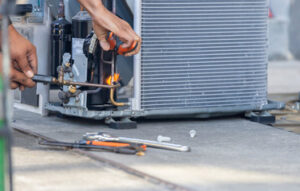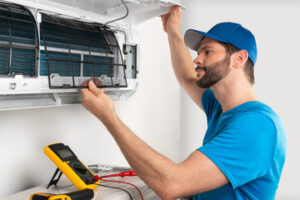It’s easy to take your home’s air quality for granted. After all, you think the pollutants outside are far away.

But indoor air often contains as much as five times more pollution than outdoors. This makes IAQ services critical. Keep reading the article below to learn more about Indoor Air Quality Services.
The main benefit of IAQ services is that they provide a safer and healthier environment for people inside buildings. In addition to removing airborne contaminants, they help reduce respiratory problems and increase comfort and productivity levels. They also protect against the effects of Sick Building Syndrome, which is a term to describe occupants experiencing illness and fatigue as a result of spending long periods of time inside a poorly ventilated indoor space.
These services include addressing the sources of air pollution, including dust, pet dander and mold. They also focus on reducing odors, balancing humidity and improving energy efficiency in HVAC systems. In addition, they may conduct a thorough inspection and testing for asbestos (if required).
Keeping up with routine maintenance is a good way to maintain air quality in your home. However, this does not necessarily address the problem of lingering odors or air pollutants that accumulate in ductwork over time.
Our technicians are committed to helping you understand the causes of poor indoor air quality and providing the best solutions for your home or office. These services may involve installing advanced products that remove odors, improve ventilation and balance humidity. They may also test for volatile organic compounds (VOCs) from household cleaning products and paints, which can cause a variety of health issues.
Other potential sources of poor indoor air quality include mold, mildew and excess humidity. Humidity imbalances can foster the growth of dust mites, promote the formation of bacteria and other microorganisms, and exacerbate asthma symptoms. Persistent odors can be an indication of a mold or mildew problem or the presence of VOCs.
IAQ services are like eco-friendly superheroes, not just for the occupants of a building or home but for the planet as well. By reducing energy consumption and decreasing greenhouse gas emissions, they play an important role in combatting climate change. They also improve the efficiency of heating and cooling equipment by preventing the buildup of debris that can impede system performance. This not only extends the lifespan of equipment but saves money on energy bills.
Compliance with Health Standards
Air pollutants that accumulate inside homes or businesses can cause a variety of symptoms. These include nose bleeds, irritated eyes, rashes, headaches, breathing problems and even cancer. Professional indoor air quality services ensure that buildings’ occupants are protected by ensuring the temperature, humidity and pollution levels align with set health standards.
Some common signs of poor IAQ include stale or musty odors that indicate a buildup of mold, mildew and other contaminants. Smelly air can also indicate a lack of proper ventilation. A lack of fresh air can lead to a buildup of dust on surfaces that can trigger allergies and respiratory conditions. In addition, if you notice that your symptoms worsen when you spend time indoors or are more prevalent during the winter, it may be a sign that poor IAQ is to blame.
Poor indoor air quality can impact a business’ bottom line as well as its reputation among customers and employees. Many governmental and regulatory agencies have specific guidelines in place that must be adhered to by commercial buildings, including those that provide healthcare facilities. IAQ testing helps businesses meet these requirements and protects the health of their occupants, which can help them avoid expensive fines.
In hospitals, IAQ is especially important because of the high level of pollutants in the building environment. These pollutants include airborne germs, chemical substances and medical compounds. Poor hospital IAQ can also result in patients experiencing health issues such as headaches, fatigue and breathing problems.
Proper building operations and maintenance are critical to ensuring healthy IAQ. This can be accomplished by maintaining building heating and ventilation systems, regularly cleaning and sanitizing spaces, following guidelines for ensuring adequate ventilation when rooms are rearranged and properly storing cleaning and other chemicals used in the workplace. Another important aspect of building operations and maintenance is performing post-construction IAQ testing to make sure there are no residual contaminants left behind from the construction process. The best way to do this is through air sampling. This is done by bringing a mobile laboratory to the site and collecting samples of the air with different sensors. The results can tell you whether there are still high levels of VOCs such as formaldehyde, TVOCs or volatile organic compounds lingering in the space.
Environmentally Friendly
Keeping indoor air clean and healthy is not only good for you but for the environment as well. Using green technology, such as smart sensors that monitor environmental conditions, ensures that your home is always at the ideal comfort level and eliminates pollutants from the air without increasing your energy consumption. This is especially important since studies have shown that indoor air can be two to five times more polluted than outdoor air.
Whether you are a business owner looking to create an environmentally friendly working space or you’re simply concerned about the quality of your home’s air, IAQ services can help. Their experts can assess your indoor air and provide you with solutions that fit your unique needs. They can recommend and install efficient HVAC systems that enhance air quality with smart filtration while reducing energy consumption, such as ERVs or HRVs. They can also advise you on the use of eco-friendly cleaning methods and materials to reduce pollutants from the air.
In addition to testing for carbon monoxide, radon and other gases, IAQ services can also check for dust and allergens (including pet dander and mold), volatile organic compounds, and odors. Moreover, they can test your home for carbon monoxide leaks and check for a safe ventilation system that will remove toxic air from your indoor space and vent it outdoors.
IAQ services can also help you track indoor air quality with handheld devices that can relay real-time component levels to mobile apps. This makes it easier to identify pollutants and take steps to prevent them from damaging your health and the environment.
Many people tend to take the quality of their indoor air for granted. After all, they are safe inside their homes where any sources of pollution are far away. However, this is a mistake because the quality of your home’s air can still be far worse than you think. You can check the air quality of your home with a simple DIY kit, or you can hire an IAQ service to conduct a comprehensive investigation. In either case, you will be able to identify the source of harmful contaminants and take measures to reduce them.
Healthier Occupants
About 90 percent of people’s time is spent indoors, which makes ensuring that the air inside is clean vitally important. Poor indoor air quality can be caused by contaminants like pet dander, mold spores, volatile organic compounds (VOC), and radon gas. Fortunately, these pollutants can be detected and reduced through the use of an air quality service that specializes in these issues.
During the evaluation process, you should ask potential indoor air quality specialists questions about their methodologies and approach towards assessing and improving air quality. Their answers will give you a good sense of their problem-solving skills and ability to tailor solutions to your unique needs. If they can provide examples of past projects and references from previous clients, that’s even better.
Indoor air pollutants can be found in a variety of sources including building materials and furnishings, appliances, and occupants’ personal hygiene products. These pollutants are often released into the air through ventilation, which is why it’s crucial that indoor spaces have adequate airflow. A poor ventilation system can lead to uncomfortable odors, a stuffy feeling, and health effects such as asthma.
An IAQ service can improve your home’s ventilation by addressing leaks, sealing ductwork, and using high-efficiency air filters. These measures can help reduce irritants such as volatile organic compounds, as well as allergens and microbes. They can also help prevent odors, condensation, and humidity problems, which are all symptoms of poor indoor air quality.
Another benefit of hiring an indoor air quality service is that they can help you save on energy bills. By keeping your HVAC systems in top shape, they can operate more efficiently and minimize energy consumption. This also helps reduce greenhouse gases and carbon emissions, which are major contributors to climate change.
In addition, an IAQ service can work with you to ensure that your home’s refrigerant levels are in compliance with EPA recommendations. If yours aren’t, that could be a sign of a serious problem with your air conditioning system and may require repairs or replacement parts.
